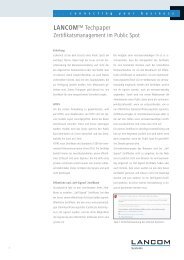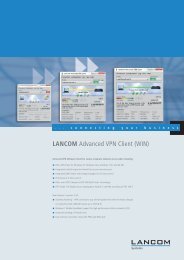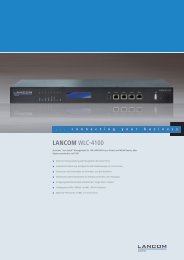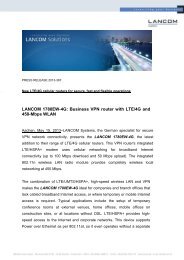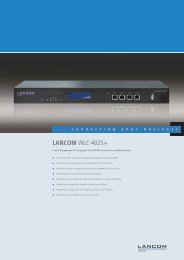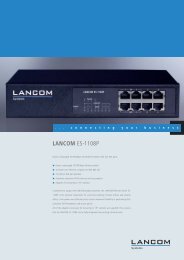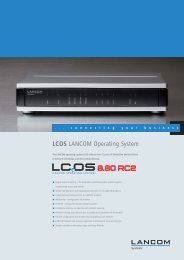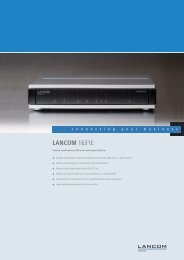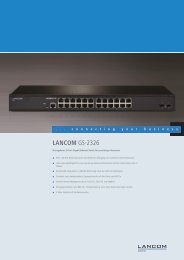LANCOM 1781VA - LANCOM Systems
LANCOM 1781VA - LANCOM Systems
LANCOM 1781VA - LANCOM Systems
You also want an ePaper? Increase the reach of your titles
YUMPU automatically turns print PDFs into web optimized ePapers that Google loves.
<strong>LANCOM</strong> <strong>1781VA</strong> Features as of: LCOS 8.82<br />
Content Filter (optional)<br />
URL filter database/rating server<br />
HTTPS filter<br />
Categories/category profiles<br />
Override<br />
Black-/whitelist<br />
Profiles<br />
Time frames<br />
Flexible firewall action<br />
Individual display pages (for blocked, error,<br />
override)<br />
Redirection to external pages<br />
License management<br />
Statistics<br />
Notifications<br />
Wizard for typical configurations<br />
Max. users<br />
Worldwide, redundant rating servers from IBM Security Solutions for querying URL classifications. Database with over 100 million entries covering<br />
about 10 billion web pages. Web crawlers automatically search and classify web sites to provide nearly 150,000 updates per day: They use text<br />
classification by optical character recognition, key word searches, classification by word frequency and combinations, web-site comparison of text,<br />
images and page elements, object recognition of special characters, symbols, trademarks and prohibited images, recognition of pornography and<br />
nudity by analyzing the concentration of skin tones in images, by structure and link analysis, by malware detection in binary files and installation<br />
packages<br />
Additional filtering of HTTPS requests with separate firewall entries<br />
Filter rules can be defined in each profile by collecting category profiles from 58 categories, for example to restrict Internet access to business<br />
purposes only (limiting private use) or by providing protection from content that is harmful to minors or hazardous content (e.g. malware sites).<br />
Clearly structured selection due to the grouping of similar categories. Content for each category can be allowed, blocked, or released by override<br />
Each category can be given an optional manual override that allows the user to access blocked content on a case-by-case basis. The override<br />
operates for a limited time period by allowing the category or domain, or a combination of both. Optional notification of the administrator in case<br />
of overrides<br />
Lists that are manually configured to explicitly allow (whitelist) or block (blacklist) web sites for each profile, independent of the rating server.<br />
Wildcards can be used when defining groups of pages or for filtering sub pages<br />
Timeframes, blacklists, whitelists and categories are collected into profiles that can be activated separately for content-filter actions. A default<br />
profile with standard settings blocks racist, pornographic, criminal, and extremist content as well as anonymous proxies, weapons/military, drugs,<br />
SPAM and malware<br />
Timeframes can be flexibly defined for control over filtering depending on the time of day or weekday, e.g. to relax controls during break times for<br />
private surfing<br />
Activation of the content filter by selecting the required firewall profile that contains content-filter actions. Firewall rules enable the flexible use of<br />
your own profiles for different clients, networks or connections to certain servers<br />
Response pages displayed by the content filter in case of blocked sites, errors or overrides can be custom designed. Variables enable the inclusion<br />
of current information such as the category, URL, and rating-server categorization. Response pages can be issued in any language depending on<br />
the language set in the user's web browser<br />
As an alternative to displaying the device's own internal response pages to blockings, errors or overrides, you can redirect to external web servers<br />
Automatic notification of license expiry by e-mail, LANmonitor, SYSLOG or SNMP trap. Activation of license renewal at any time before expiry of<br />
the current license (the new licensing period starts immediately after expiry of the current license)<br />
Display of the number of checked and blocked web pages by category in LANmonitor. Logging of all content-filter events in LANmonitor; log file<br />
created daily, weekly or monthly. Hit list of the most frequently called pages and rating results. Analysis of the connection properties; minimum,<br />
maximum and average rating-server response time<br />
Messaging in case of content-filter events optionally by e-mail, SNMP, SYSLOG or LANmonitor<br />
Wizard sets up the content filters for a range of typical scenarios in a few simple steps, including the creation of the necessary firewall rules with<br />
the corresponding action<br />
Simultaneous checking of HTTP traffic for a maximum of 100 different IP addresses in the LAN<br />
VoIP<br />
SIP ALG<br />
The SIP ALG (Application Layer Gateway) acts as a proxy for SIP communication. For SIP calls the ALG opens the necessary ports on the firewall for<br />
the corresponding media packets. By using automatic address translation for devices inside the LAN, the use of STUN is no longer needed.<br />
Routing functions<br />
Router<br />
Advanced Routing and Forwarding<br />
HTTP<br />
DNS<br />
DHCP<br />
NetBIOS<br />
NTP<br />
Policy-based routing<br />
IP and NetBIOS/IP multi-protocol router<br />
Separate processing of 16 contexts due to virtualization of the routers. Mapping to VLANs and complete independent management and configuration<br />
of IP networks in the device, i.e. individual settings for DHCP, DNS, Firewalling, QoS, VLAN, Routing etc. Automatic learning of routing tags for<br />
ARF contexts from the routing table<br />
HTTP and HTTPS server for configuration by web interface<br />
DNS client, DNS server, DNS relay, DNS proxy and dynamic DNS client<br />
DHCP client, DHCP relay and DHCP server with autodetection. Cluster of several <strong>LANCOM</strong> DHCP servers per context (ARF network) enables caching<br />
of all DNS assignments at each router. DHCP forwarding to multiple (redundant) DHCP servers<br />
NetBIOS/IP proxy<br />
NTP client and SNTP server, automatic adjustment for daylight-saving time<br />
Policy-based routing based on routing tags. Based on firewall rules, certain data types are marked for specific routing, e.g. to particular remote<br />
sites or lines



